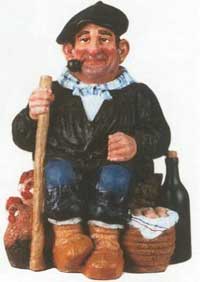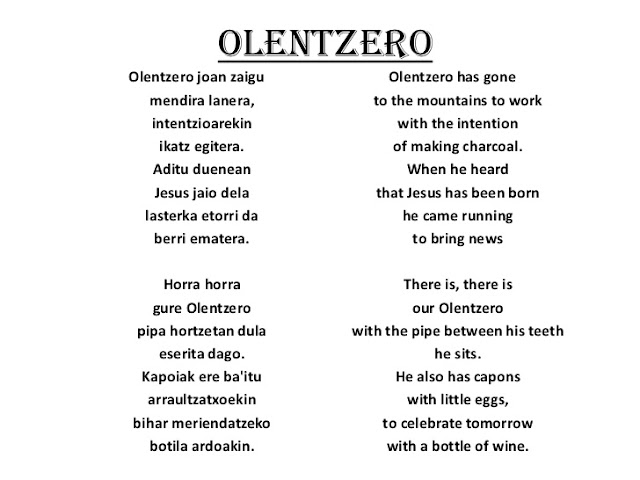Curiouser and curiouser...strange name, strange story!
O is for Olentzero ...
I admit I had not heard of this well loved but strange Christmas character before researching for this blog This big fellow is well loved at least by Basques - Who? Where?
The Basques are indigenous to and mostly live in an area traditionally known as Basque country, a region which is located around the west of the Pyrenees on the coast of Bay of Biscay and straddles parts of north -central Spain and south western France. But who is Olentzero?
There are quite a few versions of his story and how he is related to Christmas, but I like this one....
 Olentzero is a humble man with a heart filled with love. As a new born he was left alone in the woods where a fairy adopted him, gave him the name Olentzero and raised him. He turned into a strong man and worked as a charcoal maker. He was hard-working and gifted with his hands. He carved wooden animals, toys and dolls. When he had a big charcoal bag full of toys he hiked to the village in the valley and distributed the wooden figures amongst the children because he liked to see them happy. The kids loved him and Olentzero came back whenever he had finished another bag of toys.
Olentzero is a humble man with a heart filled with love. As a new born he was left alone in the woods where a fairy adopted him, gave him the name Olentzero and raised him. He turned into a strong man and worked as a charcoal maker. He was hard-working and gifted with his hands. He carved wooden animals, toys and dolls. When he had a big charcoal bag full of toys he hiked to the village in the valley and distributed the wooden figures amongst the children because he liked to see them happy. The kids loved him and Olentzero came back whenever he had finished another bag of toys.
One day as he came down to the village he found a house in flames. He dashed towards the house finding crying children behind the closed windows. Without hesitation he ran into the house and freed them by lowering them from an upstairs window. With everyone safe he went downstairs when the house collapsed under the fire, burying him. The people from the village had gathered by now outside the burning ruins and they suddenly saw a white flash leaving the flames and heading towards the sky. The fairy that had found him in the woods had come to be with him in this moment. She said, "Olentzero you have such a good heart, you even gave your life for others. You should not die. You shall live forever, making toys for all the children in this village and in the whole Basque country."
And that is now how the story is told so that on the 24th of December, the Olentzero makes his annual appearance.
Each year at Christmas, Basque villagers create an image of Olentzero , usually a papier mache or a wooden carved figure. Olentzero is characteristically dressed in the traditional peasant farmer's garb of dark pants tucked into socks below the knees; leather, rope tied shoes; a dark overshirt , a black beret, and a smoking pipe.
It's worth mentioning a couple of the other beliefs surrounding Olentzero which make him a rather curious Christmas celebrity. A common belief is that Olentzero was the last of a race of mythical giants, who all, exceot him, threw themselves off a mountain when they heard about the birth of Jesus Christ, I also found a rather strange Christmas song which alludes to Olentzero eating whole ten piglets in one sitting. However, in all the various Basque village stories and songs, Olentzero remains a revered Christmas figure, who epitomises goodness and kindness, especially towards children.
 |
| Olentzero - watercolour, pencil & pen sketch - Wilma Simmons |
I admit I had not heard of this well loved but strange Christmas character before researching for this blog This big fellow is well loved at least by Basques - Who? Where?
The Basques are indigenous to and mostly live in an area traditionally known as Basque country, a region which is located around the west of the Pyrenees on the coast of Bay of Biscay and straddles parts of north -central Spain and south western France. But who is Olentzero?
There are quite a few versions of his story and how he is related to Christmas, but I like this one....
 Olentzero is a humble man with a heart filled with love. As a new born he was left alone in the woods where a fairy adopted him, gave him the name Olentzero and raised him. He turned into a strong man and worked as a charcoal maker. He was hard-working and gifted with his hands. He carved wooden animals, toys and dolls. When he had a big charcoal bag full of toys he hiked to the village in the valley and distributed the wooden figures amongst the children because he liked to see them happy. The kids loved him and Olentzero came back whenever he had finished another bag of toys.
Olentzero is a humble man with a heart filled with love. As a new born he was left alone in the woods where a fairy adopted him, gave him the name Olentzero and raised him. He turned into a strong man and worked as a charcoal maker. He was hard-working and gifted with his hands. He carved wooden animals, toys and dolls. When he had a big charcoal bag full of toys he hiked to the village in the valley and distributed the wooden figures amongst the children because he liked to see them happy. The kids loved him and Olentzero came back whenever he had finished another bag of toys. One day as he came down to the village he found a house in flames. He dashed towards the house finding crying children behind the closed windows. Without hesitation he ran into the house and freed them by lowering them from an upstairs window. With everyone safe he went downstairs when the house collapsed under the fire, burying him. The people from the village had gathered by now outside the burning ruins and they suddenly saw a white flash leaving the flames and heading towards the sky. The fairy that had found him in the woods had come to be with him in this moment. She said, "Olentzero you have such a good heart, you even gave your life for others. You should not die. You shall live forever, making toys for all the children in this village and in the whole Basque country."
And that is now how the story is told so that on the 24th of December, the Olentzero makes his annual appearance.
It's worth mentioning a couple of the other beliefs surrounding Olentzero which make him a rather curious Christmas celebrity. A common belief is that Olentzero was the last of a race of mythical giants, who all, exceot him, threw themselves off a mountain when they heard about the birth of Jesus Christ, I also found a rather strange Christmas song which alludes to Olentzero eating whole ten piglets in one sitting. However, in all the various Basque village stories and songs, Olentzero remains a revered Christmas figure, who epitomises goodness and kindness, especially towards children.

Comments
Post a Comment
Thanks for reading my blog and please share your thoughts about my blog post by leaving a comment.Your comment won't appear immediately as comments are verified before publication in an effort to reduce the amount of spam appearing. Anonymous comments will not be published.